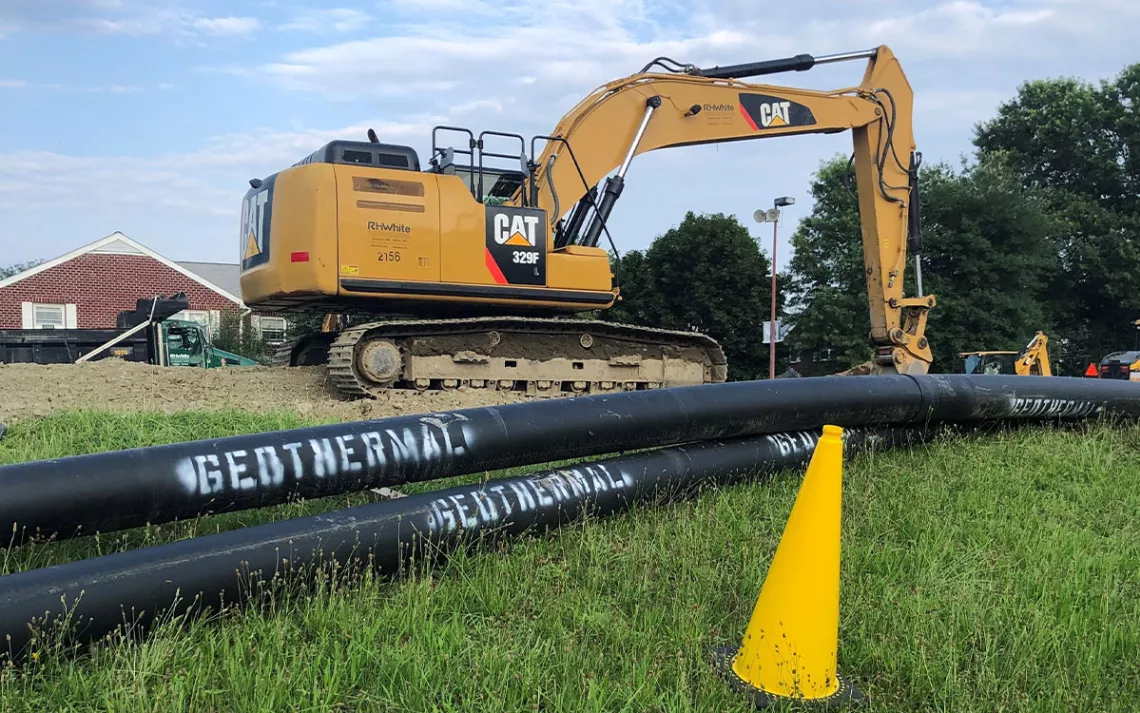Geothermal Energy Promises to Help Some Communities Get Off Fossil Gas
But can gas utilities learn to love a new business model?

Geothermal construction begins with the installation of main piping at Farley Lot. | Photo courtesy of Eversource
In a leafy neighborhood in Framingham, Massachusetts, cars traverse a freshly capped trench conveying a newly implanted pipe below the roadbed. From the jet-black strip of tar at the surface, one could imagine that the local gas company just replaced another of New England’s leaky gas mains. In fact, the infrastructure buried this year in Framingham marks a clean break from fossil-fueled business-as-usual. Rather than delivering combustible methane gas, Framingham's newest piping carries tepid water that’s the lifeblood of a geothermal energy system—technology that could help put gas pipes out of business across the United States.
Unlike most geothermal installations, which serve a single building, the pipes in Framingham function as part of a neighborhood-scale circulatory system for thermal energy—that is, energy that can heat or cool a building. The pipes form a mile-long loop that exchanges heat between buildings and the ground via 90 bore holes, each of them drilled some 600 to 700 feet down into the clay and rock below the city. When the thermal swap started in August, at the height of another brutal New England summer, it brought cooling relief to a fire hall, school, gas station, cabinet shop, city-run housing units for the elderly and disabled, and 22 single-family homes and duplexes.
Heat pumps installed in each building were doing most of the work, using electricity to squeeze heat from inside each building and dump it into the loop’s liquid flow. As New England’s summer swelter gives way to winter chill, the heat pumps will change direction, tapping thermal energy in the flowing water to keep Framingham residents, fire fighters, teachers and students warm. “Some of the heat that’s getting pushed into the ground right now will be used when we switch to heating buildings,” says Zeyneb Magavi, executive director at HEET, the Boston, Massachusetts–based climate group that drove the project’s creation.
HEET gained prominence a decade ago when the organization raised alarms over the hazards of leaking gas networks. Unfortunately, such well-placed concern accelerated spending on gas pipes, doubling-down on gas infrastructure that many customers and communities would rather be phasing out. So HEET pivoted, embracing networked geothermal energy as an alternative to gas.
Seven years later, Framingham’s installation marks a major milestone: It is the first of several geothermal loop demonstrations planned for Massachusetts. And there are more coming across the US, including more than half a dozen geothermal loop projects gestating next door in New York and two in Minnesota.
There’s little doubt that the technology will work, since hundreds of geothermal networks are already operating worldwide. What makes projects like Framingham's innovative and important is that they could put methane gas to bed and prompt gas utilities to reboot their business models, since the geothermal networks are being installed and operated by gas utilities themselves. As Magavi puts it: “This looks like a real growth model for the gas utility.”
The excitement is palpable within Eversource, the Boston-based gas and electricity provider behind the Framingham project, says Nikki Bruno, a company vice president who is leading its decarbonization strategy. Bruno calls consumer interest in networked geothermal “unique.” Forty residents signed up the first day the City of Framingham and Eversource starting taking names, according to Shawn Luz, Framingham's sustainability coordinator. Bruno says only one customer on the loop declined an Eversource offer to join, and many more wanted to join as word spread. That had Eversource, HEET, and the city thinking about a second geothermal loop months before they'd turned on the first.
Bruno says customers, communities, and developers elsewhere in its Massachusetts-Connecticut gas territory are also calling in to request their own loops. She says that embrace has energized the utility’s gas business, whose marketing group rebranded as its “customer thermal solutions” team. “You’ve given a company that was just focused on natural gas a new life to be an active participant in this energy transition,” Bruno says.
Getting gas utilities behind geothermal could galvanize climate action. The utilities and their workers have been known to fight against electrification-minded policies that push air-source heat pumps—in part because the high-efficiency machines operate without pipes and therefore without pipefitters. In contrast, the geothermal network aligns the interests of utilities and climate advocates, says Panama Bartholomy, who runs the Building Decarbonization Coalition. Bartholomy says he sees “tons of support” for geothermal networks from the same gas utility workers who are “putting political weight behind blocking every other building decarbonization policy going forward.”
Networked geothermal installed by utilities also addresses the high and uncertain up-front cost of drilling boreholes deep underground. A utility can share drilling costs across many customers, and raising capital to finance energy infrastructure is a utility’s ultimate superpower.
Broader use of geothermal energy is also a climate win, because geothermal heat pumps consume far less energy than air-sourced heat pumps and air conditioners. On the same days in August when Framingham’s geothermal heat pumps started delivering cold air, each neighboring home and business with an air-source heat pump or air conditioner was likely using twice as much electricity, or more. That’s because the air-source equipment had to eject the unwanted heat into the even hotter air outside—akin to blowing air into a balloon that’s already inflated. All the geothermal heat pumps had to do was make the loop’s tepid water a little warmer.
The geothermal network’s advantages over stand-alone heat pumps will be even more apparent during the coming heating season. Framingham’s air-source heat pumps will yet again fight an uphill battle, delivering heat by wringing thermal energy from the chilly outside air while the geothermal heat pumps are tapping the loop’s much warmer water.
Geothermal's efficiency could be a big deal for power grids that must expand to keep up amid accelerating electrification and climate-change-intensified extreme weather. Bruno says Eversource projects that the Framingham pilot could take some strain off its power lines in the winter even as it gets dozens of customers off gas-generated heat. That’s because other customers, especially those at the Framingham Housing Authority’s units on Rose Kennedy Lane, are leaving behind wildly inefficient electric baseboard heaters.
According to a November 2023 report from Oak Ridge National Laboratory and the National Renewable Energy Laboratory, using geothermal rather than air-source heat pumps in 70 percent of US buildings could save 593 terawatt-hours of electricity annually. That, in turn, would slash the need for new long-distance power lines by 33 percent—a huge plus given the challenge of expanding the US grid.
What networked geothermal really needs in order to take off, proponents say, is firm cost and performance data. They say that will give policymakers and investors the confidence to commit public and private dollars, and assure state regulators that utility investment in the technology is prudent for ratepayers who will ultimately be left holding the bag.
HEET has kitted out the system at Framingham with sensors to track how much energy goes where and when, including how the subsurface warms and cools over time. Its project partners include Boston University, the University of California, Berkeley, and the National Renewable Energy Laboratory. Eversource, for its part, will be integrating that performance data with information on costs. The cost picture is complex, Bruno says. It’s not just the direct costs of installation, operations, and maintenance at the Framingham loop but also costs that Eversource might avoid by trimming its gas system and building fewer power lines.
The up-front cost has already tripped up another neighborhood geothermal network that utility National Grid hopes to install northwest of Boston in Lowell. That project stalled earlier this year when bids came in higher than expected, including for the heat pumps supplied and installed by utilities under the state-approved projects.
Magavi predicts the Lowell project will get back on track, and chalks up the delay to a learning opportunity: “No one has yet built a clean energy system. We’re going to have to keep trying and resetting.”
 The Magazine of The Sierra Club
The Magazine of The Sierra Club



